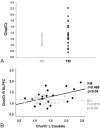Proton MR spectroscopy in the evaluation of cerebral metabolism in patients with fibromyalgia: comparison with healthy controls and correlation with symptom severity
- PMID: 18339723
- PMCID: PMC8128570
- DOI: 10.3174/ajnr.A0959
Proton MR spectroscopy in the evaluation of cerebral metabolism in patients with fibromyalgia: comparison with healthy controls and correlation with symptom severity
Abstract
Background and purpose: Widespread pain sensitivity in patients with fibromyalgia (FM) suggests a central nervous system (CNS)-processing problem. Therefore, it is conceivable that metabolic alterations exist in pain-processing brain regions of people with FM compared with healthy controls (HC) and that such metabolic data could correlate with clinical symptoms. The purpose of this study was to test these hypotheses using proton MR spectroscopy ((1)H-MR spectroscopy).
Materials and methods: There were 21 patients with FM and 27 HC who underwent conventional structural MR imaging and additional 2D-chemical shift imaging (CSI) MR-spectroscopy sequences. For the 2D-CSI spectroscopy, larger volumes of interest (VOIs) were centered at the level of the basal ganglia and the supraventricular white matter. Within these larger areas, 16 smaller voxels were placed in a number of regions previously implicated in pain processing. N-acetylaspartate (NAA)/creatine(Cr), choline (Cho)/Cr and NAA/Cho ratios were calculated for each voxel. Subjects underwent clinical and experimental pain assessment.
Results: Mean metabolite ratios and ratio variability for each region were analyzed by using repeated-measures analysis of variance (ANOVA). Correlations between clinical symptoms and metabolite ratios were assessed. Cho/Cr variability in the right dorsolateral prefrontal cortex (DLPFC) was significantly different in the 2 groups; a significant correlation between Cho/Cr in this location and clinical pain was present in the FM group. Evoked pain threshold correlated significantly with NAA/Cho ratios in the left insula and left basal ganglia.
Conclusion: Our data suggest that there are baseline differences in the variability of brain metabolite relative concentrations between patients with FM and HC, especially in the right DLPFC. Furthermore, there are significant correlations between metabolite ratios and clinical and experimental pain parameters in patients with FM.
Figures



Similar articles
-
Metabolic abnormalities in pain-processing regions of patients with fibromyalgia: a 3T MR spectroscopy study.AJNR Am J Neuroradiol. 2011 Oct;32(9):1585-90. doi: 10.3174/ajnr.A2550. Epub 2011 Jul 28. AJNR Am J Neuroradiol. 2011. PMID: 21799042 Free PMC article. Clinical Trial.
-
Hippocampus dysfunction may explain symptoms of fibromyalgia syndrome. A study with single-voxel magnetic resonance spectroscopy.J Rheumatol. 2008 Jul;35(7):1371-7. Epub 2008 May 15. J Rheumatol. 2008. PMID: 18484688
-
Evaluation of early cerebral metabolic, perfusion and microstructural changes in HCV-positive patients: a pilot study.J Hepatol. 2013 Oct;59(4):651-7. doi: 10.1016/j.jhep.2013.05.008. Epub 2013 May 13. J Hepatol. 2013. PMID: 23680314
-
Proton MR spectroscopy in Rett syndrome.Comput Med Imaging Graph. 2002 Jul-Aug;26(4):271-5. doi: 10.1016/s0895-6111(02)00016-2. Comput Med Imaging Graph. 2002. PMID: 12074922 Review.
-
Clinical proton MR spectroscopy in central nervous system disorders.Radiology. 2014 Mar;270(3):658-79. doi: 10.1148/radiol.13130531. Radiology. 2014. PMID: 24568703 Free PMC article. Review.
Cited by
-
Increased cortical activation upon painful stimulation in fibromyalgia syndrome.BMC Neurol. 2015 Oct 20;15:210. doi: 10.1186/s12883-015-0472-4. BMC Neurol. 2015. PMID: 26486985 Free PMC article.
-
A neurometabolite study of chronic daily headache in patients with systemic lupus erythematosus using magnetic resonance spectroscopy: comparison with fibromyalgia patients and healthy controls.Korean J Intern Med. 2016 Nov;31(6):1171-1177. doi: 10.3904/kjim.2015.196. Epub 2016 Mar 25. Korean J Intern Med. 2016. PMID: 27017392 Free PMC article.
-
3D magnetic resonance spectroscopic imaging reveals links between brain metabolites and multidimensional pain features in fibromyalgia.Eur J Pain. 2021 Oct;25(9):2050-2064. doi: 10.1002/ejp.1820. Epub 2021 Jun 22. Eur J Pain. 2021. PMID: 34102707 Free PMC article.
-
Herbal medicinal products or preparations for neuropathic pain.Cochrane Database Syst Rev. 2019 Apr 2;4(4):CD010528. doi: 10.1002/14651858.CD010528.pub4. Cochrane Database Syst Rev. 2019. PMID: 30938843 Free PMC article.
-
Metabolic abnormalities in pain-processing regions of patients with fibromyalgia: a 3T MR spectroscopy study.AJNR Am J Neuroradiol. 2011 Oct;32(9):1585-90. doi: 10.3174/ajnr.A2550. Epub 2011 Jul 28. AJNR Am J Neuroradiol. 2011. PMID: 21799042 Free PMC article. Clinical Trial.
References
-
- Wolfe F, Ross K, Anderson J, et al. The prevalence and characteristics of fibromyalgia in the general population. Arthritis Rheum 1995;38:19–28 - PubMed
-
- Lautenbacher S, Rollman GB, McCain GA. Multi-method assessment of experimental and clinical pain in patients with fibromyalgia. Pain 1994;59:45–53 - PubMed
-
- Kosek E, Hansson P. Modulatory influence on somatosensory perception from vibration and heterotopic noxious conditioning stimulation (HNCS) in fibromyalgia patients and healthy subjects. Pain 1997;70:41–51 - PubMed
-
- Petzke F, Clauw DJ, Ambrose K, et al. Increased pain sensitivity in fibromyalgia: effects of stimulus type and mode of presentation. Pain 2003;105:403–13 - PubMed
-
- Arroyo JF, Cohen ML. Abnormal responses to electrocutaneous stimulation in fibromyalgia. J Rheumatol 1993;20:1925–31 - PubMed
Publication types
MeSH terms
Substances
LinkOut - more resources
Full Text Sources
Medical
